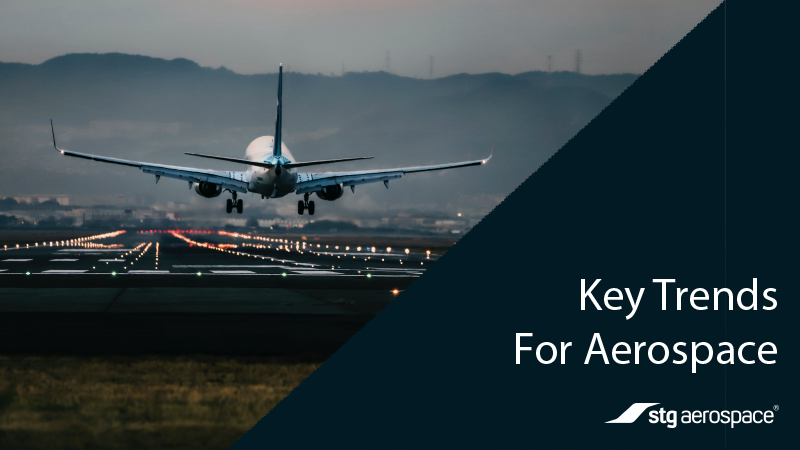What does 2023 hold in store for aerospace?

With 2022 firmly in the rear-view mirror and all eyes now trained on what’s to come, the commercial aviation market is faced with a year of opportunities for innovation and expansion. As we near the three-year anniversary of the global outbreak of Covid-19, airlines and manufacturers alike are buoyed by the prospect of a full year free of restrictions, and so the industry’s full focus is now on progress.
But what will progress bring? What will 2023 look like in commercial aviation? Our Sales and Programming Director, Pierre Michard, has outlined the opportunities and challenges he expects the industry to be faced with over the coming 12 months.
OEM Delays and faster spares
The launch of Boeing 777X aircraft has been delayed time and time again, with its introduction now not expected until at least 2025. As a result, airlines like Emirates are turning to retrofitting to plug the gap. Single aisle ramp-ups are also facing delays, creating a similar opportunity – as well as demand – for upgrades.
Airlines are also needing spare parts much faster than ever before, to support more flexible operations. We are increasingly seeing spare part orders placed for consumption in the same week as the original order, and we expect to see this trend accelerate in 2023. In preparation, we are working to make our production systems even more flexible to respond to such fast turn demand.
Aviation takes off in Asia
The Boeing 737 Max is back in the air in China, allowing airlines to significantly increase capacity. We have recently seen this take effect over the Chinese New Year period, with an estimated two billion trips being made across all modes of transportation during the festivities. Meanwhile, in India, the creation of Tata’s supercarrier will restructure the entire air travel industry. If Vistara is an indication of the high levels of service to be expected, we shall see significant levels of innovation from the new consolidated airline.
Customisation, but at what cost?
As airlines strive to create bespoke experiences, the industry as a whole is constantly balancing customisation needs with programming timelines. We need a vast improvement in interfacing standards to accelerate programming – which is particularly prominent when considering databus. While the Arinc committee has done an exemplary job of establishing new standards for data communication with Arinc 825, every integrator is implementing its own version established standards which impacts hardware and software systems suppliers.
Creating a greener future
As the aerospace industry begins its journey towards a more sustainable future, many working in the fields of design and manufacturing are wondering how to make their products more eco-friendly. While some manufacturers try to make their products appear greener than they really are, this only sets the industry’s efforts back.
A manufacturer may say, for example, that their product creates a weight saving of one kilogram, therefore reducing fuel burn by 0.02 kilograms of fuel per 1,000 kilometres and decreasing your carbon footprint. But, in reality, the component being made with a new lighter material may require more energy to process and create, therefore negating the reduction in fuel burn and increasing the carbon emissions. We must not solely focus on fuel burn when talking about sustainability, but on the entire manufacturing process and complete life of the product.
At STG, we are researching new materials to use within our products, and are asking ourselves throughout the process: “Are we making this change fundamentally for the right reasons, and does it have a domino effect?” We recently attended a sustainability design event as we begin this journey, and you can find out more about what we learned here. We are also partnering with BITC to help do our bit to make the world a safer, greener and fairer place.
Improved passenger experience
The current trend of a blended business and leisure travel experience is here to stay, and it will bring with it a shift in behaviours. Passengers are combining flights for a Friday business meeting with a weekend away, and airlines such as American, Delta and United have all noted this trend in thein 2022 figures. These types of passengers are far more likely to justify the extra cost of premium economy seating, which creates an increased onus on experience.
There will be a demand for differentiation from standard economy tickets in terms of comfort, style and feel. It’s just as important to be seen to be different as it is to actually be different in this regard. It’s unclear whether ‘bleisure’ is a long-term trend, but premium economy seat numbers are predicted to triple from 2021 to 2025, so airlines would be wise to keep tabs. Throughout 2023 and beyond, cabin interiors designers will be tasked with creating that clear differentiation in premium economy.
The year ahead of us is incredibly exciting, both for STG Aerospace and the industry as a whole. The opportunities will no doubt be countered by challenges as the year goes by, but we are looking forward to working with the wider industry to play our part in its progress.
